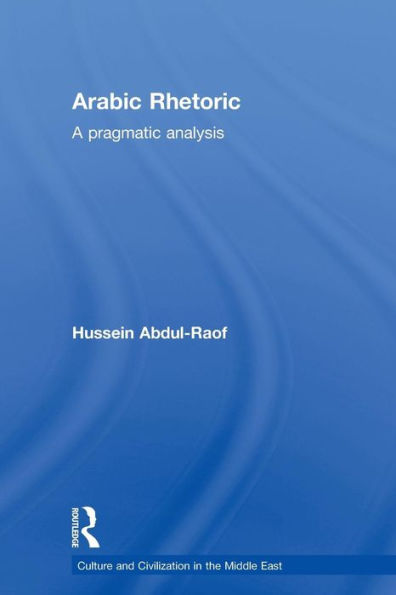Table of Contents
List of figures xi
Preface xiii
Introduction 1
1 Preamble to Arabic rhetoric 8
1.1 Introduction 8
1.2 Rhetoric and grammar 8
1.3 The role of rhetoric 15
1.4 The order system in Arabic rhetoric 16
1.5 The order system and i'jaz 18
1.6 Research in Arabic rhetoric 19
1.7 Disciplines of Arabic rhetoric 25
1.8 Prominent rhetoricians 30
2 Historical review 31
2.1 Introduction 31
2.2 The birth of rhetorical studies 31
2.3 Development of rhetorical studies 33
2.4 The stagnation period of rhetorical studies 52
2.4.1 Simplified summaries 55
2.5 The notion of i'jaz in rhetorical studies 57
2.6 Modern period of rhetorical studies 60
2.6.1 Modern approach to rhetorical studies 61
2.7 Chronological summary of rhetoricians 66
2.8 Conclusion 68
3 Eloquence and rhetoric 75
3.1 Introduction 75
3.2 Research in eloquence 75
3.3 What is eloquence? 76
3.3.1 Aspects of eloquence 77
3.3.1.1 Eloquence of the lexical item 77
3.3.1.1.1 Phonetic incongruity 77
3.3.1.1.2 Stylistic oddity 79
3.3.1.1.2.1 Semantic ambiguity 79
3.3.1.1.2.2 Unfamiliar usage 80
3.3.1.1.2.3 Inaccurate usage 80
3.3.1.1.2.4 Morphological incongruity 83
3.3.1.1.2.5 Calques, loan words, and neologisms 84
3.3.1.1.3 Violation of morphological system 85
3.3.1.1.4 Repugnant sounds 86
3.3.1.2 Eloquence of the proposition 87
3.3.1.2.1 Lexical incongruity 87
3.3.1.2.2 Grammatical incongruity 89
3.3.1.2.3 Stylistic incongruity 90
3.3.1.2.4 Semantic incongruity 90
3.3.1.3 Eloquence of the communicator 91
3.4 What is rhetoric? 91
3.4.1 Aspects of rhetoric 93
3.5 Distinction between eloquence and rhetoric 94
3.6 Conclusion 95
4 Word order 97
4.1 Introduction 97
4.2 The order system 98
4.3 Historical review of the order system 98
4.4 Word order 100
4.4.1 Word order and pragmatic effect 100
4.5 Reporting 103
4.5.1 Pragmatic functions of reporting 104
4.5.2 Affirmation of reporting 108
4.5.2.1 Affirmation tools in reporting 108
4.5.2.2 Grammatical affirmation techniques in reporting 110
4.5.3 Modes of reporting 111
4.5.3.1 Departure from modes of reporting 113
4.6 Informing 115
4.6.1 Modes of informing 115
4.7 Foregrounding and backgrounding 121
4.8 Al-musnad ilaihi 122
4.8.1 Grammatical functions of al-musnad ilaihi 123
4.8.2 Linguistic features and pragmatic functions of al-musnad ilaihi 127
4.8.2.1 Occurrence of al-musnad ilaihi 127
4.8.2.2 Ellipsis of al-musnad ilaihi 133
4.8.2.3 Definiteness of al-musnad ilaihi 136
4.8.2.3.1 Definiteness by the definite article ($) 136
4.8.2.3.2 Definiteness by a pronoun 138
4.8.2.3.3 Definiteness by a proper, common, or abstract noun 140
4.8.2.3.4 Definiteness by a demonstrative pronoun 141
4.8.2.3.5 Definiteness by a relative pronoun 142
4.8.2.3.6 Definiteness by a construct noun phrase 144
4.8.2.3.7 Definiteness by vocative particle ($) 145
4.8.2.4 Indefiniteness of al-musnad ilaihi 145
4.8.2.5 Foregrounding of al-musnad ilaihi 146
4.8.2.5.1 Pragmatic functions of foregrounded al-musnad ilaihi 147
4.8.2.6 Backgrounding of al-musnad ilaihi 150
4.8.2.6.1 Grammatical factors of backgrounding 150
4.8.2.6.2 Pragmatic functions of backgrounding 150
4.9 Al-musnad 153
4.9.1 Grammatical functions of al-musnad 153
4.9.2 Linguistic features and pragmatic functions of al-musnad 157
4.9.2.1 Definiteness of al-musnad 157
4.9.2.2 Indefiniteness of al-musnad 158
4.9.2.3 Ellipsis of al-musnad 159
4.9.2.4 Foregrounding of al-musnad 160
4.10 The verb and its attachments 161
4.10.1 What are the verb's attachments? 162
4.10.1.1 Categories of the verb 163
4.10.1.1.1 Conditional and hypothetical sentences 163
4.10.1.2 The pragmatic functions of object 164
4.10.1.2.1 Foregrounding of the object 164
4.10.1.2.2 Ellipsis of the object 165
4.11 Restriction 166
4.11.1 What is restriction? 166
4.11.2 The linguistic tools of restriction 168
4.11.3 The modifier and modified 170
4.11.4 Categories of restriction 171
4.11.5 Forms of restriction 173
4.11.6 Pragmatic functions of restriction 175
4.12 Conjunction and disjunction 176
4.12.1 Conjunction 177
4.12.1.1 The linguistic environment of conjunction 111
4.12.1.2 The linguistic prerequisites of conjunction 118
4.12.1.3 The semantic prerequisites of conjunction 180
4.12.1.4 Other forms of conjunction 181
4.12.2 Disjunction 184
4.12.2.1 Pragmatic functions of disjunction 184
4.12.2.2 The semantic prerequisites of disjunction 185
4.12.2.3 The linguistic environment of disjunction 187
4.13 Succinctness, verbosity, and moderation 188
4.13.1 Succinctness 188
4.13.1.1 Brevity succinctness 189
4.13.1.2 Elliptical succinctness 189
4.13.2 Verbosity 190
4.13.3 Moderation 192
4.14 Conclusion 192
5 Figures of speech 196
5.1 Introduction 196
5.2 What is ?ilm al-bayan? 197
5.3 Simile 198
5.3.1 What is simile? 198
5.3.2 Simile components 199
5.3.2.1 The simile feature 200
5.3.2.2 The simile element 203
5.3.3 Absence of simile element and feature 204
5.3.4 Simile categories 206
5.3.5 Types of simile 207
5.3.6 Pragmatic functions of simile 208
5.4 Allegory 209
5.4.1 What is allegory? 209
5.4.2 Categories of allegory 212
5.4.2.1 Cognitive allegory 212
5.4.2.1.1 Pragmatic functions of cognitive allegory 216
5.4.2.2 Linguistic allegory 217
5.4.2.2.1 Metaphor 218
5.4.2.2.1.1 Metaphor components 218
5.4.2.2.1.2 Types of metaphor 219
5.4.2.2.2 Hypallage 225
5.5 Metonymy 233
5.5.1 What is metonymy? 233
5.5.2 Categories of metonymy 235
5.6 Summary 238
6 Embellishments 239
6.1 Introduction 239
6.2 What are embellishments? 239
6.3 Historical review of al-badi' studies 241
6.3.1 Al-badi' poets 243
6.4 Categories of embellishments 243
6.4.1 Semantic embellishments 244
6.4.2 Lexical embellishments 259
Conclusion 271
Glossary of Arabic rhetoric 278
Notes 291
Bibliography 308
Index 311



